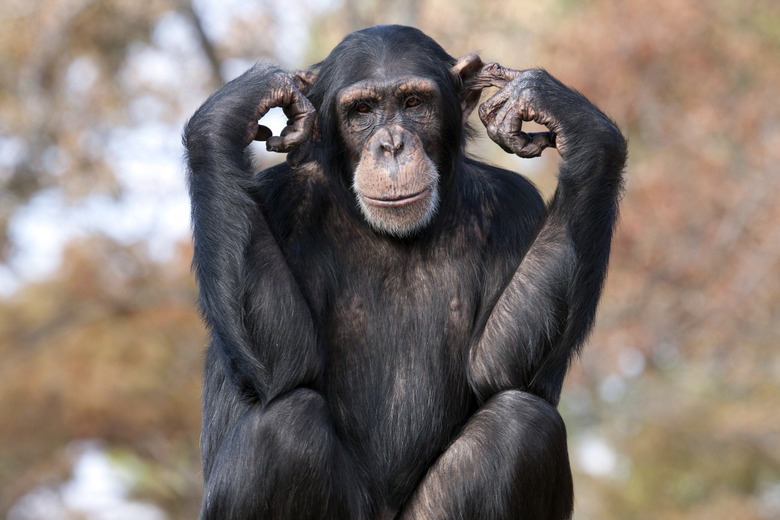Chimpanzee Adaptation
Chimpanzees, great apes originating in Africa, represent the closest living relatives to humans. In fact, chimpanzees and humans share 96 percent of their DNA sequence. Chimpanzees use a number of distinguishing adaptations to survive among trees and on the ground. These adaptations range from locomotive to social to genetic.
TL;DR (Too Long; Didn't Read)
Chimpanzees display a number of adaptations to help them survive. Some of these adaptations include opposable thumbs, locomotive adaptations, sharp senses, large brains, tool creation and use, complex social communities and genetic adaptations to their environments.
Opposable Thumbs
Opposable Thumbs
Like humans, chimpanzees possess hands with four fingers and an opposable thumb. This thumb allows chimpanzees to grasp and climb trees. Chimpanzees also use their skilled hands to groom each other. The opposable thumb gives chimpanzees the ability to make and use tools as well.
Locomotive Adaptations
Locomotive Adaptations
Chimpanzees have long arms in proportion to their legs. The long arms provide a means for chimpanzees to clamber and swing on branches. This adaptation is called forelimb-suspensory locomotion. The shorter legs work well on the ground for walking, running and even standing, but chimpanzees are not bipedal like humans. They walk on their knuckles and feet as quadrupeds; their hind limbs provide most of the support for their body mass. These hind limbs also grant chimpanzees propulsion. Chimpanzees possess no tail, enabling them to sit easily.
Sensory Adaptations
Sensory Adaptations
Like humans, chimpanzees have keen eyesight. They also have good senses of smell and hearing. All sensory adaptations allow chimpanzees to stay aware of predators and to search for their food.
Large Brain
Large Brain
Perhaps the most remarkable adaptation of chimpanzees is their larger brains relative to their body size. This adaptation gives them considerable intelligence. Chimpanzees even recognize their own mirror image. Adept learners, chimpanzees can follow instructions and make their own tools. Chimpanzees also posses a special kind of neuron in their brains, like humans, associated with decision making.
Tool Use
Tool Use
Chimpanzees belong to a small group of primates that make and use their own tools. They make special dipping sticks for foods such as termites, ants and honey. Chimpanzees also use twigs for toothpicks and use rocks as hammers to crack open nuts. Occasionally chimpanzees use rocks as weapons in hunting game or in aggression against other chimpanzees. Adult chimpanzees train their young to make and use such tools. One intriguing distinction in chimpanzee tool construction is that of tool elongation. Learned tool use among some populations of chimpanzees stretches over many generations.
Social Group Adaptations
Chimpanzees adapted to form a highly social community in order to survive, comprising a large community broken into a number of smaller subgroups. Competition and cooperation result from their intelligence. Chimpanzees manipulate, deceive, control their emotions and otherwise actively engage in a complex social environment. Adult females pass on learned knowledge to their young, such as which foods are safe to eat and how to crack nuts. Adult male chimpanzees hunt for monkeys and game in cooperative groups. They also provide boundary security.
Communication Skills
Communication Skills
Chimpanzees possess highly expressive faces and adopt certain body positions based on social circumstances. They quickly pass along important information through visual or vocal means. Expressions such as grins and pouts convey different meanings, alerting other chimpanzees to features or potential threats in their surroundings. Various body movements relay information about dominance, excitement and aggression. Vocalizations such as hoots, grunts and screams convey different feelings during eating, travel and interactions with other chimpanzees.
Genetic Adaptation to Environment
Genetic Adaptation to Environment
In central Cameroon, scientists discovered three distinct populations of chimpanzees. Each population adapted to different aspects of their environment enough that changes took place at the genetic level. The genetic differences grew to the point of separating these populations into subspecies. Given their threatened status, these groups of chimpanzees prove to be exceptionally sensitive to habitat loss. This indicates the crucial need for conservation to preserve these unique primates.
References
- NIH National Human Genome Research Institute: New Genome Comparison Finds Chimps, Humans Very Similar at the DNA Level
- University of Wisconsin – Madison: National Primate Research Center: Chimpanzee Pan Troglodytes
- University of Wisconsin – La Crosse: The Chimpanzee – Adaptation
- Palomar College: Adaptations of Group Living
- Philosophical Transactions of the Royal Society B: Tool Use as an Adaptation
- Drexel University: Studies of Africa's Most Endangered Chimpanzees Show Complex Evolutionary Past, Perilous Future
Cite This Article
MLA
Hermance, Dianne. "Chimpanzee Adaptation" sciencing.com, https://www.sciencing.com/chimpanzee-adaptation-6541129/. 25 April 2018.
APA
Hermance, Dianne. (2018, April 25). Chimpanzee Adaptation. sciencing.com. Retrieved from https://www.sciencing.com/chimpanzee-adaptation-6541129/
Chicago
Hermance, Dianne. Chimpanzee Adaptation last modified March 24, 2022. https://www.sciencing.com/chimpanzee-adaptation-6541129/
